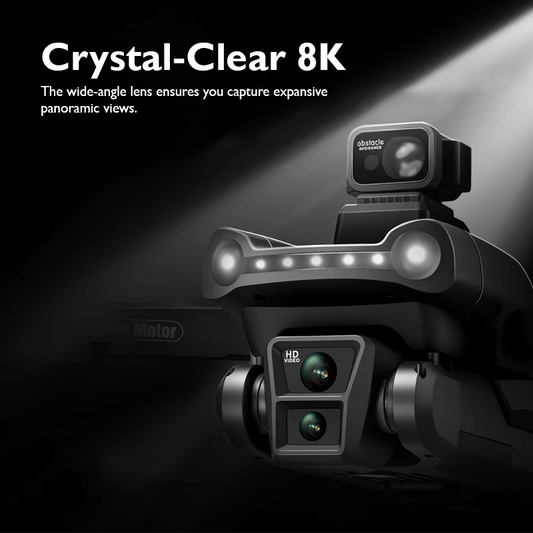Photographing Wildlife with Drones: Tips for Success

In the ever-evolving realm of photography, the integration of drones has revolutionised the way we capture the world around us. One fascinating niche where drones have made a significant impact is wildlife photography. Photographing wildlife with drones opens up a whole new perspective, allowing photographers to capture stunning images that were once impossible to achieve. In this article, we'll delve into the exciting world of wildlife photography with drones and provide you with valuable tips for success.
1.Choosing the Right Drone for Wildlife Photography:

Selecting the right drone is the first crucial step towards successful wildlife photography. Opt for a drone with a high-quality camera, preferably one with a zoom lens. The ability to zoom in on your subjects without disturbing them is essential for capturing those intimate moments in the wild. Drones like the DJI Mavic 2 Zoom or the Autel Robotics EVO Lite+ offer excellent camera capabilities, making them ideal choices for wildlife enthusiasts.
2.Research Your Wildlife Subjects:
Before you launch your drone into the wild, it's essential to understand the behaviour of the animals you wish to photograph. Researching their habits, preferred habitats, and movement patterns will increase your chances of capturing compelling shots. Familiarise yourself with the best times of day for wildlife activity and plan your drone photography sessions accordingly.
3.Respect Wildlife and the Environment:

While drones offer an incredible tool for wildlife photography, it's crucial to prioritise the well-being of the animals and their natural habitats. Maintain a safe distance from wildlife to avoid causing stress or disturbance. Always adhere to local regulations and ethical guidelines, ensuring that your drone flights have minimal impact on the environment and its inhabitants.
4.Mastering Drone Flight Skills:

To capture stunning wildlife shots, you must be adept at piloting your drone. Practice flying in different conditions, such as varying altitudes and wind speeds, to build confidence in handling your equipment. Smooth, controlled movements are essential for getting close to wildlife without causing alarm, so take the time to master the art of flying your drone with precision.
5.Utilise Intelligent Flight Modes:
Many modern drones come equipped with intelligent flight modes that can greatly enhance your wildlife photography experience. Features like Active Track and Follow Me mode can help you effortlessly track and capture moving subjects. These modes automate the flight process, allowing you to focus on composing the perfect shot while the drone takes care of the navigation.
6.Optimise Camera Settings:

Understanding your drones camera settings is crucial for achieving professional-quality wildlife photographs. Experiment with different shutter speeds, ISO levels, and white balance settings to find the optimal configuration for the lighting conditions. When photographing wildlife, using a faster shutter speed is advisable to freeze motion and capture sharp, detailed images.
7.Plan Your Shots and Composition:

Successful wildlife photography requires careful planning and consideration of composition. Before taking off, visualise the shots you want to capture and plan your drone's flight path accordingly. Pay attention to framing, rule of thirds, and leading lines to create visually appealing and impactful images. Planning your shots in advance will help you make the most of your time in the field.
8.Use ND Filters for Better Results:

Neutral density (ND) filters are essential accessories for drone photographers seeking to improve image quality. These filters reduce the amount of light entering the camera, allowing you to achieve a more natural motion blur in bright conditions. Using ND filters can enhance the visual appeal of your wildlife shots and add a professional touch to your aerial photography.
9.Be Patient and Persistent:
Wildlife photography, whether done with traditional cameras or drones, requires patience and persistence. Wildlife behaviour can be unpredictable, so be prepared to spend time waiting for the perfect moment. Keep your drone in the air, observe your surroundings, and be ready to capture those magical moments that unfold in the wild.
10.Post-Processing Techniques:

After your drone photography session, dedicate time to post-processing to enhance the visual impact of your images. Crop and adjust exposure, contrast, and saturation to bring out the best in your wildlife shots. Experiment with different editing techniques to achieve a style that complements the natural beauty of the subjects you've captured.
Photographing wildlife with drones is a thrilling and rewarding experience that offers a unique perspective on the natural world. By choosing the right equipment, respecting wildlife and the environment, mastering flight skills, and applying effective photography techniques, you can elevate your drone wildlife photography to new heights. Remember to approach this art form with a sense of responsibility, prioritising the well-being of the subjects you're capturing. With the right mindset and skills, you can create stunning visuals that not only showcase the beauty of wildlife but also contribute to the conservation of our planet's precious ecosystems. Happy droning!
Explore a variety of drones at our online drone store.
Happy Flying!









